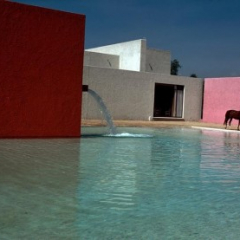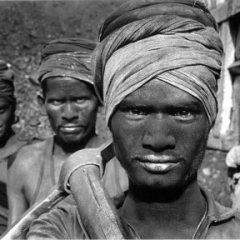Leni Riefenstahl is one of the most controversial artistic personalities of the 20th century. The first exhibition since her death deals with her mythos once and for all, and brings the artist back to life.
“Reality does not interest me.” The tragedy of the artist Leni Riefenstahl is embodied in this credo. Thanks to her stubborn refusal to accept reality and the complete absence of self-critical reflection on her connection to the Hitler regime, she was considered a persona non grata in Germany and was boycotted as film producer. She found this a very unjust punishment. Shortly before her death in 2002 she spoke about blind hate and spite: “I have never understood why they have so attacked and avoided me in Germany.” Instead of processing her own past, she created a story about an apolitical artist interested merely in beauty.
Stasi intrigues against Riefenstahl
This exhibition also provides other new information, however. For the first time, East-German Stasi activities aimed at preventing Riefenstahl’s rehabilitation in Germany. Pictures showing Riefenstahl’s shocked face as she witnesses the massacre of Jews in Poland are shown. In 1952 the Stasi passed these on to the illustrated magazine “Revue” in order to prevent her acquittal in the denazification processes in Berlin.
Another fact presented in the exhibition deals with the well-known photos taken during the 1936 Olympic games. They were not taken by her after all, but rather by her fellow photographers Arthur Grimm, Rolf Lantin, Willy Zielke and the Hitler photographer (who recently died), Walter Frentz.
More than “just” documentation
The myth that she was just a documenter filming current happenings is finally taken care of once and for all. The exchange of letters between her and the Minister of Defense in the Third Reich, Albert Speer, show that some scenes in her first film covering the Nazi party convention were re-filmed in the studio in the presence of highly-placed Nazi personalities. The desired production serving propaganda was thus created out of the filmed documentation. This fact was vehemently disputed by Riefenstahl her whole life long.
Printed in the Stern
Her stubborn adherence to her life lies made an artistic new start in Germany impossible. She re-entered the public scene in the 1960s as a photographer. Her photographs of the legendary Nuba tribe were featured in the German magazine “Stern” in 1969. The general editor at the time, Henri Nannen, also happened to have been a commentator at the Olympic games in Berlin in 1936 – where Riefenstahl recorded her famous two-part film Olympia (“Festival of the People” and “Festival of Beauty”).
Riefenstahl Renaissance in the 1990s
While she had long been recognized abroad (the US-American “Time” magazine included her as the only woman among the “100 most influential and impressive artists of the 20th century”), in Germany it took until the late 1990s for her life work to be appreciated and before reconciliation with this contradictory personality was possible for the German society. Whether the reason for that is seen as the triumph of her mythos or as the result of a changed society which, freed from old ideological weight, had become able to separate the aesthetic from its content, is up to each person to decide for himself.
In any case, the exhibition has accomplished two things: it has destroyed Riefenstahl’s mythos and (perhaps therefore) makes a new perspective and view of her work possible. Her films and pictures have not lost any of their fascination over the years.
Carsten Heidböhmer

